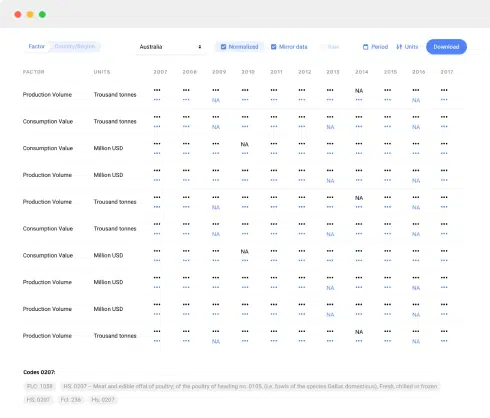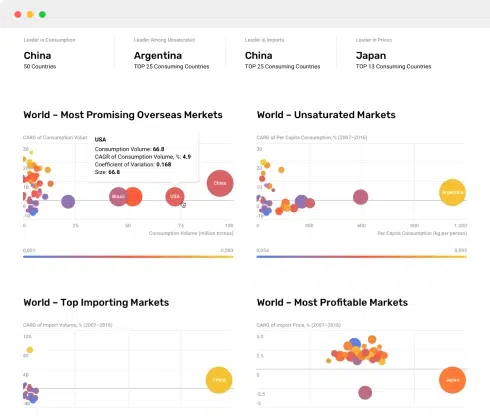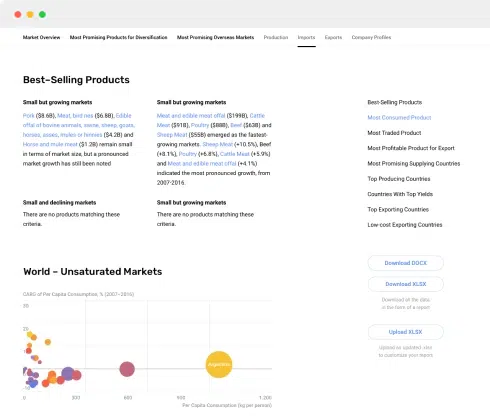
"Sony and Soundcore Dominate Premium and Mass Segments; JBL Shows Elasticity at Mid-Price Points"
Introduction
Understanding brand positioning on marketplaces requires a data-driven approach to pricing, reviews, and sales volume. This analysis leverages IndexBox dashboard visualizations to uncover strategic insights for brands competing in the audio equipment market. We examine five key metrics—rating vs. reviews, price elasticity, market share, price distribution, and assortment variability—to derive actionable recommendations.
Methodology
The analysis is based on aggregated marketplace data parsed via IndexBox, covering:
All data is normalized to median benchmarks for comparative analysis.
1. Rating vs. Reviews: Identifying Brand Segments
The scatter plot divides brands into four quadrants:
| Segment | Brands (Examples) | Recommendations |
| Star Brands (High Rating + High Reviews) | Sony, JBL | Reinforce loyalty programs, expand premium offerings. |
| Rising Brands (Low Rating + High Reviews) | MUSICOZY, TOZO | Improve product quality; address negative feedback systematically. |
| Niche Brands (High Rating + Low Reviews) | Sennheiser | Increase visibility via influencer marketing and targeted ads. |
| Problematic Brands (Low Rating + Low Reviews) | JVC, Linsoul | Conduct root-cause analysis; consider rebranding or product revamp. |
Key Insight: Brands like Sony and JBL benefit from strong reputations, while MUSICOZY must prioritize quality to sustain growth.
2. Price vs. Sales Volume: Elasticity and Strategy
The scatter plot reveals four strategic clusters:
| Cluster | Brands | Insight | Recommendation |
| High Price / Low Volume | Audio-Technica, Jabra | Premium, low elasticity | Focus on exclusivity; reduce SKUs to optimize margins. |
| Low Price / High Volume | Soundcore, JBL | Mass-market, high elasticity | Expand distribution; leverage promotions. |
| High Price / High Volume | Sony, Sennheiser | Premium with scale | Justify pricing via innovation (e.g., noise cancellation). |
| Low Price / Low Volume | JVC, Linsoul | Stagnant positioning | Reassess pricing or differentiate features. |
Key Insight: JBL demonstrates elasticity at mid-price points (+338% sales at $117 avg. price), suggesting optimal penetration pricing.
3. Price Distribution: Segmentation Opportunities
The histogram highlights:
Recommendations:
4. Market Share: Leaders vs. Challengers
The pie chart shows:
Strategic Moves:
5. Price Dispersion: Assortment Optimization
The boxplot reveals:
Recommendation:
Custom Search Request
IndexBox enables on-demand parsing via:
Conclusion
Next Steps: Regular monitoring via IndexBox to track shifts in elasticity and competition.
1. INTRODUCTION
Making Data-Driven Decisions to Grow Your Business
- REPORT DESCRIPTION
- RESEARCH METHODOLOGY AND THE AI PLATFORM
- DATA-DRIVEN DECISIONS FOR YOUR BUSINESS
- GLOSSARY AND SPECIFIC TERMS
2. EXECUTIVE SUMMARY
A Quick Overview of Market Performance
- KEY FINDINGS
- MARKET TRENDSThis Chapter is Available Only for the Professional EditionPRO
3. MARKET OVERVIEW
Understanding the Current State of The Market and its Prospects
- MARKET SIZE: HISTORICAL DATA (2012–2024) AND FORECAST (2025–2035)
- MARKET STRUCTURE: HISTORICAL DATA (2012–2024) AND FORECAST (2025–2035)
- TRADE BALANCE: HISTORICAL DATA (2012–2024) AND FORECAST (2025–2035)
- PER CAPITA CONSUMPTION: HISTORICAL DATA (2012–2024) AND FORECAST (2025–2035)
- MARKET FORECAST TO 2035
4. MOST PROMISING PRODUCTS FOR DIVERSIFICATION
Finding New Products to Diversify Your Business
- TOP PRODUCTS TO DIVERSIFY YOUR BUSINESS
- BEST-SELLING PRODUCTS
- MOST CONSUMED PRODUCTS
- MOST TRADED PRODUCTS
- MOST PROFITABLE PRODUCTS FOR EXPORTS
5. MOST PROMISING SUPPLYING COUNTRIES
Choosing the Best Countries to Establish Your Sustainable Supply Chain
- TOP COUNTRIES TO SOURCE YOUR PRODUCT
- TOP PRODUCING COUNTRIES
- TOP EXPORTING COUNTRIES
- LOW-COST EXPORTING COUNTRIES
6. MOST PROMISING OVERSEAS MARKETS
Choosing the Best Countries to Boost Your Export
- TOP OVERSEAS MARKETS FOR EXPORTING YOUR PRODUCT
- TOP CONSUMING MARKETS
- UNSATURATED MARKETS
- TOP IMPORTING MARKETS
- MOST PROFITABLE MARKETS
7. PRODUCTION
The Latest Trends and Insights into The Industry
- PRODUCTION VOLUME AND VALUE: HISTORICAL DATA (2012–2024) AND FORECAST (2025–2035)
8. IMPORTS
The Largest Import Supplying Countries
- IMPORTS: HISTORICAL DATA (2012–2024) AND FORECAST (2025–2035)
- IMPORTS BY COUNTRY: HISTORICAL DATA (2012–2024)
- IMPORT PRICES BY COUNTRY: HISTORICAL DATA (2012–2024)
9. EXPORTS
The Largest Destinations for Exports
- EXPORTS: HISTORICAL DATA (2012–2024) AND FORECAST (2025–2035)
- EXPORTS BY COUNTRY: HISTORICAL DATA (2012–2024)
- EXPORT PRICES BY COUNTRY: HISTORICAL DATA (2012–2024)
10. PROFILES OF MAJOR PRODUCERS
The Largest Producers on The Market and Their Profiles
LIST OF TABLES
- Key Findings In 2024
- Market Volume, In Physical Terms: Historical Data (2012–2024) and Forecast (2025–2035)
- Market Value: Historical Data (2012–2024) and Forecast (2025–2035)
- Per Capita Consumption: Historical Data (2012–2024) and Forecast (2025–2035)
- Imports, In Physical Terms, By Country, 2012–2024
- Imports, In Value Terms, By Country, 2012–2024
- Import Prices, By Country, 2012–2024
- Exports, In Physical Terms, By Country, 2012–2024
- Exports, In Value Terms, By Country, 2012–2024
- Export Prices, By Country, 2012–2024
LIST OF FIGURES
- Market Volume, In Physical Terms: Historical Data (2012–2024) and Forecast (2025–2035)
- Market Value: Historical Data (2012–2024) and Forecast (2025–2035)
- Market Structure – Domestic Supply vs. Imports, in Physical Terms: Historical Data (2012–2024) and Forecast (2025–2035)
- Market Structure – Domestic Supply vs. Imports, in Value Terms: Historical Data (2012–2024) and Forecast (2025–2035)
- Trade Balance, In Physical Terms: Historical Data (2012–2024) and Forecast (2025–2035)
- Trade Balance, In Value Terms: Historical Data (2012–2024) and Forecast (2025–2035)
- Per Capita Consumption: Historical Data (2012–2024) and Forecast (2025–2035)
- Market Volume Forecast to 2035
- Market Value Forecast to 2035
- Market Size and Growth, By Product
- Average Per Capita Consumption, By Product
- Exports and Growth, By Product
- Export Prices and Growth, By Product
- Production Volume and Growth
- Exports and Growth
- Export Prices and Growth
- Market Size and Growth
- Per Capita Consumption
- Imports and Growth
- Import Prices
- Production, In Physical Terms: Historical Data (2012–2024) and Forecast (2025–2035)
- Production, In Value Terms: Historical Data (2012–2024) and Forecast (2025–2035)
- Imports, In Physical Terms: Historical Data (2012–2024) and Forecast (2025–2035)
- Imports, In Value Terms: Historical Data (2012–2024) and Forecast (2025–2035)
- Imports, In Physical Terms, By Country, 2024
- Imports, In Physical Terms, By Country, 2012–2024
- Imports, In Value Terms, By Country, 2012–2024
- Import Prices, By Country, 2012–2024
- Exports, In Physical Terms: Historical Data (2012–2024) and Forecast (2025–2035)
- Exports, In Value Terms: Historical Data (2012–2024) and Forecast (2025–2035)
- Exports, In Physical Terms, By Country, 2024
- Exports, In Physical Terms, By Country, 2012–2024
- Exports, In Value Terms, By Country, 2012–2024
- Export Prices, By Country, 2012–2024


